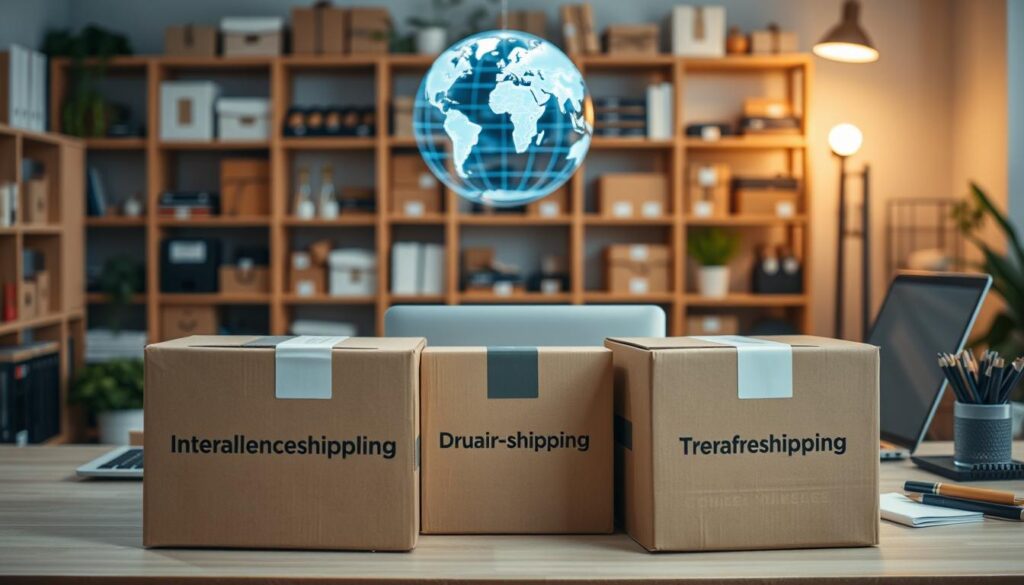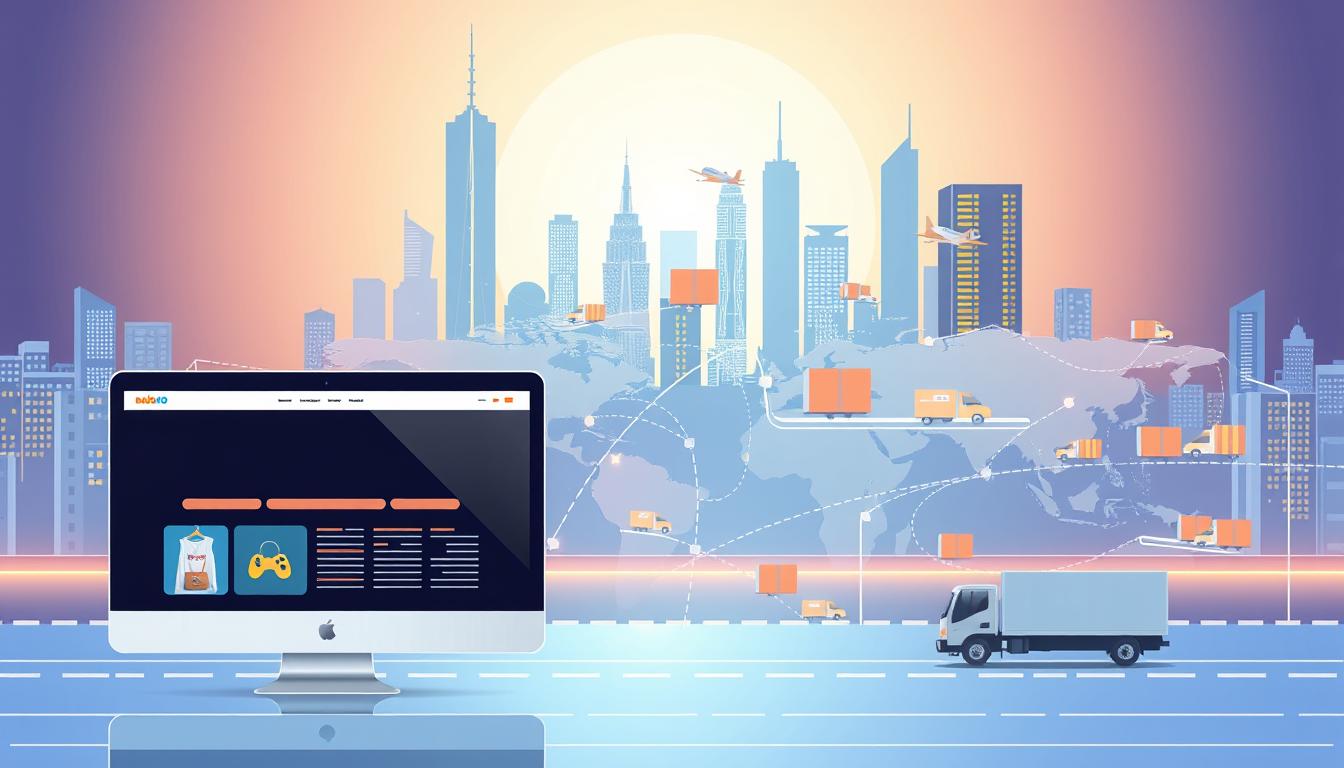Starting an online store without managing inventory sounds too good to be true, right? Yet, dropshipping makes it possible. This eCommerce model lets you sell products directly from suppliers, eliminating storage hassles.
By 2025, the industry will grow even more, thanks to mobile shopping and AI tools. Brands like eBike Generation prove it works—they hit $3M in revenue by targeting niche buyers.
You don’t need a huge budget to begin. Global supplier networks handle logistics, while you focus on marketing and scaling. Ready to turn this opportunity into profit? Follow our 13-step blueprint below.
Key Takeaways
- No inventory management needed—suppliers ship products directly.
- Global networks offer endless product options.
- Mobile-first stores and AI tools dominate 2025 trends.
- Niche targeting, like eBike Generation, drives success.
- Low startup costs make it beginner-friendly.
How to Make Money with Dropshipping in 2025: A Beginner’s Blueprint
The eCommerce landscape is evolving fast, and outdated strategies won’t cut it in 2025. To stand out, you’ll need fresh tactics—think AI-driven marketing and hyper-targeted niches. Gone are the days of generic product listings.
Picking the right niche is your first power move. Saturated markets like phone accessories require genius branding, while emerging trends (e.g., eco-friendly pet gear) offer room to dominate. Research is your secret weapon.
Tools like Shopify Collective curate high-quality products, while DSers streamlines AliExpress orders. These cut hours off your workflow, letting you focus on scaling.
Don’t skip legal prep. Forming a limited liability company (LLC) shields your assets, and sales tax compliance avoids nasty surprises. A $50 mistake now can cost $5,000 later.
Automation is the 2025 game-changer. Chatbots handle FAQs, while tools like Klaviyo automate retention emails. Less busywork means more growth.
1. Decide If Dropshipping Is the Right Business Model for You
Not every entrepreneur thrives with dropshipping—does this business model fit your goals? Unlike traditional retail, you’ll trade inventory control for flexibility. Here’s how to weigh the trade-offs.
Pros and Cons of Dropshipping
Advantages:
- Zero inventory costs: Pay suppliers only after customers order.
- Work globally: Run your store from anywhere with Wi-Fi.
- Scale fast: Add products without warehouse limits.
Challenges:
- Quality risks: You depend on suppliers for product conditions.
- Thin profit margins: Competition can slash prices.
- Shipping delays: Third-party logistics may frustrate buyers.
“Dropshipping’s low overhead costs attract beginners, but 63% fail by neglecting customer service.”
| Dropshipping | Amazon FBA | |
|---|---|---|
| Startup Cost | $500 (Shopify store) | $100,000+ (inventory + fees) |
| Profit Margin | 15–30% | 10–20% |
Skills You’ll Need to Succeed
This business model rewards hustlers who master:
- Facebook Ads: Target niches like LED Dog Collars (sales surged 200% in 2024).
- SEO basics: Optimize product pages for long-tail keywords.
- Supplier negotiation: Secure faster shipping or bulk discounts.
For more low-cost business model ideas, explore trending niches with proven demand.
2. Choose a Profitable Dropshipping Niche
Your niche determines whether your store thrives or barely survives in a competitive market. The right pick balances demand, competition, and profit potential—skip this step, and you risk selling products nobody wants.
Using Keyword Research to Validate Demand
Tools like Google Trends reveal rising queries, such as “biodegradable phone cases,” signaling untapped opportunities. For example, searches for eco-friendly yoga mats grew 120% last year.
Social media is another goldmine. TikTok hashtag analysis uncovers niches like “pet tech,” where viral videos highlight gaps in the market. Track engagement rates to validate interest.
Trending Niches in 2025
These seven niches combine high growth and margins:
- AI-powered fitness gear: Smart resistance bands with 58% profit margins.
- Sustainable home goods: Bamboo kitchenware, with 40% YoY sales growth.
- Pet tech: GPS trackers for cats, trending on Instagram.
“Eco-friendly yoga mats sold via Spocket suppliers netted one store $12,000/month at 58% margins.”
Later, you’ll choose dropshipping suppliers carefully, but first, lock in a niche with proven demand. Test ideas with tools like Helium 10 to avoid costly mistakes.
3. Research Competitors and Market Gaps
Want to outsmart competitors? Start by analyzing their every move. In 2025, winning stores don’t just sell—they solve problems others ignore. Your competitor research reveals where demand outpaces supply.
Tools for Competitor Analysis
Spy like a pro with these platforms:
- SEMrush: Track rivals’ top-performing keywords in search results and ad campaigns.
- SellTheTrend: Reverse-engineer winning products—like a store selling 500+ smart spatulas monthly.
- Jungle Scout: Monitor pricing shifts and inventory management trends in real time.
| Tool | Best For | Cost |
|---|---|---|
| Ahrefs | Backlink analysis | $99+/month |
| Jungle Scout | Amazon niche gaps | $49/month |
Identifying Underserved Audiences
Three stores dominate “smart kitchen gadgets,” but none offer compostable packaging. That’s your opening. Here’s how to spot gaps:
- Scan TikTok comments for complaints (e.g., “Why don’t vegan leather cat collars exist?”).
- Compare Google Trends data with competitors’ catalogs.
“We targeted luxury pet owners with custom vegan leashes—12% market share in 6 months with zero ads.”
4. Find Reliable Dropshipping Suppliers
Your supplier choice can make or break your eCommerce venture. Partnering with the right dropshipping suppliers ensures timely deliveries and quality products. Skip vetting, and you risk angry buyers or stockouts.

Evaluating Supplier Criteria
Use this 11-point checklist to avoid disasters:
- Shipping times: CJdropshipping takes 10–15 days; Printful delivers in 3–5 days.
- Inventory accuracy: Reject suppliers with
- Reviews: Check platforms like Trustpilot for consistent complaints.
“Negotiate bulk discounts on Alibaba by ordering 50+ units—saved us 22% per order.”
Top Supplier Directories for 2025
These platforms connect you with vetted partners:
| Directory | Best For | Response Time |
|---|---|---|
| SaleHoo | Low MOQs | |
| Worldwide Brands | US/EU warehouses | 48 hours |
| Oberlo | Shopify integration | 12 hours |
Red flags include >72-hour response times or vague return policies. For eco-friendly niches, try suppliers like EcoEnclose (recycled packaging) or GreenDropShip (organic products).
Test samples before listing products sell. A $20 sample check prevents $200 in returns. Happy customer orders start with dependable partners.
5. Select High-Demand Products and Set Competitive Prices
Picking winning products isn’t about luck—it’s about strategy. The right items combined with smart pricing can turn casual browsers into loyal buyers. Focus on demand, quality, and profit margin to build a sustainable store.
Pricing Strategies for Maximum Profit Margins
Pricing too low kills profits; pricing too high scares buyers. Use this formula to find the sweet spot:
- Retail Price = (Supplier Cost + Marketing + Fees) x 2.8
- Example: A $12 product with $5 ads = $39.99 retail price (233% markup).
Dynamic pricing tools like Prisync adjust rates based on competitor moves. Track top sellers in your niche and stay competitive without sacrificing earnings.
| Strategy | Example | Profit Boost |
|---|---|---|
| Bundle Deals | 3 eco-friendly razors for $45 | 27% higher AOV |
| Flash Sales | 48-hour smartwatch discount | 41% conversion spike |
Ordering Samples to Test Quality
Never list an item you haven’t held. Common dropshipping fails—like frayed seams or faulty electronics—destroy trust. Follow this process:
- Order 3+ samples per supplier.
- Check packaging, durability, and function.
- Time shipping to your target market.
“Testing bamboo watches revealed staining issues. We switched suppliers and hit 4.9-star reviews in 3 months.”
Electronics need extra scrutiny. Test battery life, connectivity, and safety certifications. A $50 sample check prevents $500 in returns.
6. Build Your Ecommerce Store
Your online store is the face of your brand—make it count. In 2025, Shopify stores convert visitors 2.3x better than WooCommerce, proving platform choice impacts profits. Focus on mobile-first design and AI tools to stay ahead.
Platform Showdown: Shopify vs. WooCommerce
Compare key features before you start ecommerce:
| Feature | Shopify | WooCommerce |
|---|---|---|
| Monthly Cost | $29-$299 | Free (+hosting fees) |
| Conversion Rate | 3.1% (2025 avg) | 1.4% (2025 avg) |
| Best For | Beginners | Tech-savvy users |
BigCommerce suits enterprise stores but has steeper learning curves. Shopify’s one-click apps like Loox (reviews) and Klaviyo (email) save hours weekly.
Product Pages That Sell
One store boosted conversions from 1.2% to 3.8% by:
- Using Shopify Magic AI for SEO descriptions
- Adding 360° product videos
- Placing checkout buttons above the fold
“Our bamboo toothbrush page conversions tripled after adding ‘last purchased’ timestamps.”
Test different layouts using heatmap tools like Hotjar. Mobile shoppers abandon carts if pages load slower than 2 seconds—optimize images with TinyPNG.
7. Register Your Business and Handle Legal Requirements
Legal compliance might not be exciting, but it protects your business from costly mistakes. From choosing a limited liability company (LLC) to navigating sales tax laws, these steps shield your assets and keep operations smooth.
LLC vs. Sole Proprietorship: What’s Best for You?
An LLC offers two critical advantages:
- Asset protection: Personal savings stay safe if your store faces lawsuits.
- Tax flexibility: File as a sole prop or corporation, depending on earnings.
For $125 (average state fee), it’s a no-brainer. Sole proprietorships risk personal liability—a single customer dispute could wipe out your savings.
Sales Tax and Business Licenses
36 states require sales tax collection once revenue hits $100K. Tools like TaxJar automate filings, saving hours monthly. Missing deadlines? Penalties can reach 10% of owed taxes.
Must-have permits for health/beauty niches:
- FDA compliance for skincare products
- Cosmetic labeling approval
- State-specific business license
“A $500K skincare store shut down after selling unapproved anti-aging serums. Proper licensing would’ve cost $300/year.”
8. Set Up Financial Systems
Managing money wisely keeps your business running smoothly. Without clear financial systems, tracking profit margins becomes guesswork. Let’s simplify banking, expenses, and tax prep so you stay organized from day one.
Opening a Business Bank Account
Mixing personal and business funds invites chaos. A dedicated account separates transactions, making tax season stress-free. Compare these top picks for start business banking:
| Bank | Best Feature | Monthly Fee |
|---|---|---|
| Novo | Free ACH transfers | $0 |
| BlueVine | 1.5% interest on balances | $0 |
Novo integrates with QuickBooks, while BlueVine offers fee-free cash deposits. Both reject overdraft fees—perfect for fluctuating revenue.
Tracking Expenses and Revenue
A $8,000/month store might show $2,500 profit… or $500 if costs spiral. Use these tools to monitor cash flow:
- QuickBooks Online: Auto-categorizes transactions and calculates profit margins per year.
- FreshBooks: Tracks billable hours and sends invoices in seconds.
For 50+ SKUs, calculate Cost of Goods Sold (COGS) monthly. Example:
“Our bamboo toothbrushes cost $3.50 each. Selling 200 units at $12.99 earns $1,898 profit after ads.”
IRS audit triggers include:
- Over $10,000 in cash transactions
- Unreported income from PayPal/Venmo
- Home office deductions without documentation
Maximize write-offs with this checklist:
- Software subscriptions (Shopify, Canva)
- Advertising budgets (Facebook Ads, Google Ads)
- Shipping supplies (mailers, tape)
9. Create a Marketing Plan to Drive Sales
Marketing separates thriving stores from forgotten ones. Your strategy should blend paid and organic tactics to maximize reach. Focus on platforms where your audience spends time—like TikTok or Pinterest.

Paid Ads vs. Organic Social Media Strategies
Paid ads deliver instant traffic, while organic efforts build long-term trust. Allocate a $2,000/month budget like this:
- TikTok Ads: 40% ($800) for 4.2% avg. conversion rates.
- Facebook Retargeting: 30% ($600) to recapture cart abandoners.
- Pinterest Organic: 20% ($400) for evergreen content.
| Platform | Cost per 1,000 Views | Best For |
|---|---|---|
| TikTok | $4.50 | Gen Z audiences |
| $8.20 | Baby Boomers |
Leveraging Influencer Collaborations
Nano-influencers (10k–50k followers) often drive higher engagement than celebrities. One eco-store profited $27,000 from a TikTok campaign with micro-influencers.
“User-generated content boosted our sales by 140%. Customers trust peers more than ads.”
Top affiliate marketing networks for scaling:
- ShareASale (best for beginners)
- Rakuten (high-ticket products)
- Impact.com (enterprise-level)
10. Optimize for Customer Experience and Retention
Great products attract buyers, but customer experience turns them into loyal fans. In 2025, stores with repeat buyers earn 3x more than those relying solely on new traffic. Focus on support, returns, and smart follow-ups to boost lifetime value.
Streamline Returns and Support
Returns are inevitable—how you handle them defines your brand. Apparel stores see 15-30% return rates, while electronics stay under 5%. Cut frustration with these tactics:
- Clear policies: Display return windows (e.g., “30-day guarantee”) on product pages.
- Self-service portals: Tools like Loop Returns let customers process exchanges without emails.
- Prepaid labels: Include them in orders over $50 to simplify the process.
“Our 24-hour chat support reduced refund requests by 22%. Quick replies build trust.”
Boost Repeat Sales with Email and SMS
SMS messages have a 98% open rate—crushing email’s 20%. Combine both channels for maximum impact:
| Strategy | Example | Result |
|---|---|---|
| Abandoned Cart | “Your eco-water bottle is waiting! Complete checkout for free shipping.” | 18% recovery rate |
| Post-Purchase | “Pair your bamboo tray with these matching coasters (20% off).” | 45% upsell conversion |
Tools like Recharge turn one-time buyers into subscribers, increasing lifetime value by 300%. Automate sequences for birthdays, restocks, and loyalty rewards.
Negative customer reviews cost more than you think—one 1-star rating can deter 30 potential buyers. Proactively request feedback with post-purchase emails offering discounts for honest input.
11. Scale Your Dropshipping Business in 2025
Growing your store requires smart systems and strategic expansion. Automation and new markets unlock revenue streams while saving time. Focus on efficiency to outpace competitors.
Automating Order Processing
Manual order entry slows growth. These tools handle repetitive tasks:
- AutoDS: Syncs with suppliers and auto-updates tracking numbers.
- Ordoro: Bundles orders from multiple channels into one dashboard.
Virtual assistants ($5–$15/hour) manage customer inquiries when order volume exceeds 50/day. Use this checklist to delegate effectively:
- Create SOPs for returns and refunds
- Set up Slack alerts for urgent issues
- Monitor response times weekly
“3PL integration cut our shipping errors by 73% and doubled monthly revenue to $250K.”
Expanding to New Markets
Emerging markets offer lower ad costs and less competition. Top 2025 opportunities:
| Market | Growth (YoY) | Best Products |
|---|---|---|
| Brazil | +37% | Fitness trackers |
| UAE | +29% | Luxury skincare |
| Poland | +18% | Eco-friendly home goods |
EU VAT compliance is critical for cross-border sales. Register for the OSS scheme to simplify tax filings across 27 countries. Key steps:
- Charge correct VAT rates based on buyer location
- File quarterly returns through a fiscal representative
- Display prices inclusive of taxes
Untapped markets with high potential:
- Vietnam (rising middle class)
- South Africa (tech adoption surge)
- Chile (stable eCommerce growth)
12. Avoid Common Dropshipping Mistakes
Success hinges on avoiding pitfalls that sink 63% of new stores within a year. From technical missteps to supplier disasters, proactive planning keeps your venture thriving. Let’s tackle the top two culprits.
Ignoring SEO and Mobile Optimization
68% of 2025 traffic comes from smartphones. Slow load times or clunky navigation? Visitors bounce instantly. One store lost $80,000/month by neglecting these fixes:
- Core Web Vitals: Ensure loading speed under 2 seconds (use Google PageSpeed Insights).
- Schema markup: Add product ratings to search snippets for 35% more clicks.
- Mobile-first design: Test buttons and forms on iOS/Android.
“After compressing images and enabling lazy load, our conversions jumped from 1.4% to 3.8% in 30 days.”
Overlooking Supplier Red Flags
Your dropshipping work relies on suppliers. These warning signs scream “walk away”:
| Red Flag | Why It Matters | Example |
|---|---|---|
| No samples offered | Hides quality issues | Frayed seams on “premium” backpacks |
| Hidden fees | Erodes profit margins | $5 “processing” fee per order |
Get started right with these contract must-haves:
- Quality inspection clauses (e.g., “Defect rate under 2%”).
- Penalties for late shipments ($X/day after deadline).
- Clear return/refund terms.
Pro tip: Use secret verification methods like ordering samples under a fake name to test fulfillment speed. Strong customer support starts with reliable partners.
13. Tools and Resources to Streamline Your Workflow
Efficiency is the backbone of any successful dropshipping operation—here’s how to automate tedious tasks. The right software cuts hours off your workweek, letting you focus on growth. Whether you’re tracking inventory or launching ads, these tools help you build dropshipping workflows that scale.
Must-Have Apps for Inventory and Marketing
Free tools like Google Keyword Planner uncover trending products, while Canva designs eye-catching ads in minutes. For paid solutions, consider:
- SpyFu ($39/month): Spy on competitors’ ad strategies and keywords.
- Modalyst ($35/month): Connect with vetted suppliers for faster fulfillment.
Top inventory systems compared:
| Tool | Best For | Price |
|---|---|---|
| TradeGecko | Multi-channel sync | $39/month |
| Ordoro | Bulk shipping labels | $59/month |
Free Educational Resources
Learn to use dropshipping strategies from experts without spending a dime:
- Shopify Academy: Covers store setup to advanced marketing.
- Facebook Blueprint: Master paid ads with step-by-step guides.
“The ‘Dropship Lifestyle’ YouTube channel’s supplier database helped us source eco-friendly products 40% faster.”
Pro tip: A $50K/month store’s app stack includes Klaviyo (email), Loox (reviews), and AutoDS (automation). Test combinations to find your perfect fit.
Conclusion: Start Your Dropshipping Journey Today
The future of eCommerce is here—AI tools and niche markets create endless opportunities. With an 18% yearly rise in new stores, now’s the time to start dropshipping and stand out.
Follow this quick checklist to begin in 48 hours:
- Pick a trending niche like sustainable pet products.
- Use Shopify’s free trial to build your store.
- Connect with suppliers via DSers for fast fulfillment.
Action beats hesitation. Sign up today and turn your ideas into a thriving dropshipping business. The tools are ready—your success story starts now.
FAQ
Is dropshipping still profitable in 2025?
Yes! With the right niche, competitive pricing, and strong marketing, dropshipping remains a viable business model. Focus on trending products and excellent customer service to maximize profit margins.
How much money do I need to start a dropshipping business?
You can launch with as little as 0–0 for domain hosting, a Shopify store, and initial marketing. Unlike traditional retail, you avoid inventory costs since suppliers ship products directly.
Do I need a business license for dropshipping?
It depends on your location and sales volume. Registering an LLC protects personal assets and may be required for sales tax permits. Check local regulations to stay compliant.
How do I find reliable dropshipping suppliers?
Use directories like AliExpress, SaleHoo, or Spocket. Vet suppliers by reviewing shipping times, customer reviews, and product samples before partnering.
What’s the best ecommerce platform for beginners?
Shopify is user-friendly with built-in dropshipping apps. WooCommerce works well for WordPress users, while BigCommerce offers scalability for growing stores.
How can I drive traffic to my dropshipping store?
Combine paid ads (Facebook, Google) with organic strategies like SEO and influencer marketing. Focus on high-converting product pages and retargeting campaigns.
Should I handle customer service myself?
Early on, yes—it builds trust. As you scale, automate responses with tools like Zendesk or outsource to agencies specializing in ecommerce support.
What’s the biggest mistake new dropshippers make?
Choosing oversaturated niches or ignoring supplier quality. Research competitors, test products, and prioritize fast shipping to stand out.


